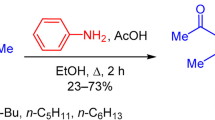Abstract
Diphenylphosphine oxidatively adds to the Re≡Re bonds of Re2 X 4(μ-dppm)2 (X=Cl or Br; dppm=Ph2PCH2PPh2) and Re2Cl4(μ-dpam)2 (dpam=Ph2AsCH2AsPh2) to afford the dirhenium(III) complexes Re2(μ-X)(μ-PPh2)HX 3(μ-LL)2. The dppm complexes have also been prepared from the reactions of Re2(μ-O2CCH3)X 4(μ-dppm)2 with Ph2PH, and a similar strategy has been used to prepare Re2(μ-Cl)(μ-PPh2)HCl3(μ-dmpm)2 (dmpm=Me2PCH2PMe2) from Re2(μ-O2CCH3)Cl4(dmpm)2. Phenylphosphine likewise reacts with Re2 X 4(μ-dppm)2 to give Re2(μ-X)(μ-PHPh)HX 3(μ-dppm)2. An X-ray crystal structure determination on Re2(μ-Cl)(μ-PPh2)HCl3(μ-dppm)2 confirms its edge-shared bioctahedral structure. This complex crystallizes in the space group\(R\bar 3\) (No. 148) witha=21.699(3) Å, α=84.50(4)°,V=10084(5) Å3, andZ=6. The structure was refined toR=0.049 (R w 0.069) for 5770 data withI>3.0σ(I). The Re-Re distance is 2.5918(7) Å. Oxidation of the bromide complex Re2(μ-Br)(μ-PPh2)HBr3(μ-dppm)2 with NOPF6 produces the unusual dirhenium(III, II) cation [Re2(μ-H)(μ-Br)[P(O)Ph2]Br2(NO)(μ-dppm)2]+ which has been structurally characterized as its perrhenate salt, [Re2(μ-H)(μ-Br)[P(O)Ph2]Br2(NO)(μ-dppm)2]ReO4 · 2CH2Cl2. This complex crystallizes in the space group\(P\bar 1\) (No. 2) witha=14.187(7) Å,b=16.419(5) Å,c=16.729(5) Å, α=98.76(2)°, β=110.11(3)°, γ=104.66(3)°,V=3414(6) Å3,Z=2. The structure was refined toR=0.040 (R w =0.051) for 5736 data withI>3.0σ(I). The presence of a phosphorus-bound [P(O)Ph2]− ligand, a linear nitrosyl and a bridging hydrido ligand has been confirmed. The Re-Re distance is 2.6273(8) Å.
Similar content being viewed by others
References
F. A. Cotton and R. A. Walton,Multiple Bonds Between Metal Atoms (Wiley, New York 1982).
F. A. Cotton and R. A. Walton (1985).Struct. Bonding (Berlin) 62, 1.
J. R. Ebner and R. A. Walton (1975).Inorg. Chem. 14, 1975.
R. A. Walton (1989).Polyhedron 8, 1689.
I. Ara, P. E. Fanwick, and R. A. Walton (1992),Polyhedron 11, 1277.
A. R. Cutler, D. R. Derringer, P. E. Fanwick, and R. A. Walton (1988).J. Am. Chem. Soc. 110, 5024.
M. T. Costello, D. R. Derringer, P. E. Fanwick, A. C. Price, M. I. Rivera, E. Scheiber, E. W. Siurek, III, and R. A. Walton (1990).Polyhedron 9, 573.
I. Ara, P. E. Fanwick, and R. A. Walton (1991).J. Am. Chem. Soc. 113, 1429.
N. Walker and D. Stuart (1983).Acta Crystallogr., Sect. A: Found Crystallogr. A39, 158.
D. T. Cromer,International Tables for X-Ray Crystallography, Vol. IV, Table 2.3.1 (Kynoch, Birmingham, England, 1974)
D. T. Cromer and J. T. Waber,Ibid.
K.-Y. Shih, P. E. Fanwick, and R. A. Walton (1991).J. Cluster Sci. 2, 259.
K.-Y. Shih, P. E. Fanwick, and R. A. Walton (1992).J. Chem. Soc., Chem. Commun. p. 375.
H.-J. Haupt, P. Balsaa, and U. Florke (1987).Z. Anorg. Allg. Chem. 548, 151.
J. Powell, J. C. Brewer, G. Gulia, and J. F. Sawyer (1989).Inorg. Chem. 28, 4470;
J. Powell, E. Fuchs, M. R. Gregg, J. Phillips, and M. V. R. Stainer (1990).Organometallics 9, 387.
A. M. Arif, T. A. Bright, D. E. Heaton, R. A. Jones, and C. M. Nunn (1990).Polyhedron 9, 1573.
E. A. V. Ebsworth, A. P. McIntosh, and M. Schroder (1986).J. Organomet. Chem. 312, C41.
T. J. Barder, F. A. Cotton, D. Lewis, W. Schwotzer, S. M. Tetrick, and R. A. Walton (1984).J. Am. Chem. Soc. 106, 2882.
S. J. Chen and K. R. Dunbar (1990).Inorg. Chem. 29, 529.
W. J. Geary (1971).Coord. Chem. Rev. 7, 81.
S. B. Colbran, D. C. Craig, and S. B. Sembiring (1990).Inorg. Chim. Acta 176, 225.
D. Matt, F. Ingold, F. Balegroune, and D. Grandjean (1990).J. Organomet. Chem. 399, 349.
J.-S. Qi, P. W. Schrier, P. E. Fanwick, and R. A. Walton (1991).J. Chem. Soc., Chem. Commun. 1737.
P. Guillaume, H. Li Kam Wah, and M. Postel (1991).Inorg. Chem. 30, 1828.
Author information
Authors and Affiliations
Rights and permissions
About this article
Cite this article
Ara, I., Fanwick, P.E. & Walton, R.A. The oxidative addition of diphenylphosphine and monophenylphosphine to the electron-rich rhenium-rhenium triple bond. The isolation and characterization of compounds that contain the four-center Re(μ-X)(μ-PR2)Re cluster (X=halide). J Clust Sci 3, 83–102 (1992). https://doi.org/10.1007/BF00814613
Received:
Issue Date:
DOI: https://doi.org/10.1007/BF00814613




